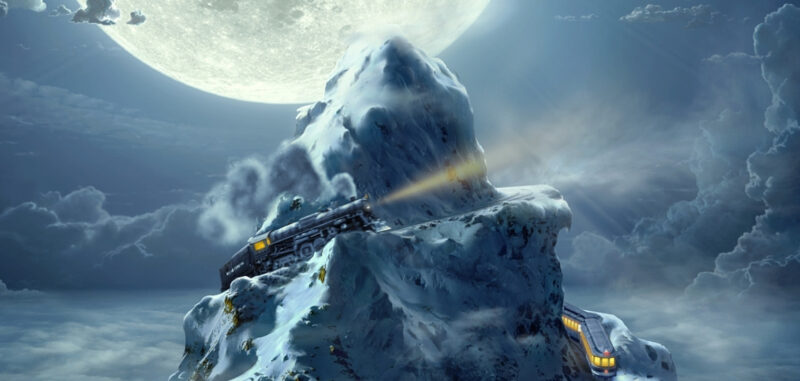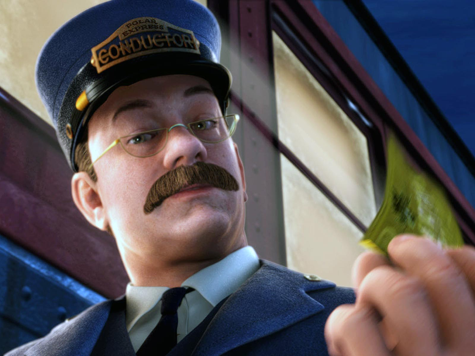The Polar Express (Robert Zemeckis, 2004) A recent study from the American Sociological Review found that Americans believe atheists are the group least likely to share in their “vision of American society”. (Previous studies have confirmed that atheists also rank as the most strongly disliked group in America.) But in the interest of religious freedom—including the freedom to have none at all—Film Comment presents commentary by the inimitable Ken Jacobs in time for Passover and Easter. Religion has always offered easily digestible answers to our questions, going back to way before it was known as religion. To when it was the best, most cohesive-seeming science a tribe waking to existence could come up with. Religions are, in fact, primitive sciences that hold onto their places in our lives because they’re rooted to individual childhood anxieties, recurrent from generation to generation. The child is afraid of the dark, of abandonment. The fundamental thing about religious lore is that it can be believed, for a while—a product of the mind it is perfectly suited to absorption by the mind, but while such answers may allay anxiety—like Mama’s watching over us from Heaven—they invariably introduce anxieties of their own (are we performing the anxiety-reducing rituals perfectly?), especially as the mind outgrows them. Guilt, self-rejection coming from our growing grasp of reality and growing skepticism regarding easy-to-swallow “answers” can be introduced, and the hard knocks a life will normally experience attributed to neglect of the rituals. It is to the advantage of masters to prolong childishness in us and nothing does that more effectively than a story, charmingly told and repeated, an adroit toying with fear. Spoken words still matter, lighting up the mind with images, but even more compelling is the moving picture, supported by color, words and music, with the illusion of reality clinched by 3D. Years can go into the making of a movie by experts in their craft, and then absorbed in 90 minutes (of passive attention with no backtalk) for the average feature. Dissection of a movie afterwards is almost always a learned practice only familiar to moviemakers themselves and some college graduates. It’s a rare moviemaker whose aim is not to have their product swallowed whole. We sit in the dark—no talking, please—in rows facing the screen. The camera dictates our perspective. The chance sounds of the world are replaced by a highly “doctored” soundtrack. We are tracked, we are directed, as the complexities of actuality are simplified and once again offered as one comprehensive mistake to our understanding. Few movies defy expectation. Unlike other arts, distinctive styles are unusual and almost never experienced by most film-goers. We are given the impression of a continuous movie-world behind the curtain, with each parting of the curtain a visit into it. And how many of us have put up with boring jobs, other entrapments, while waiting to live again at the movies. Falling in love again…. at the movies. While only some movies venture beyond childishness there’s also the specific film for children, or rather “the child in all of us,” for instance the Disney film with its cultivated association of “wholesomeness,” another sunny unreality. Our example today is The Polar Express (Robert Zemeckis, 2004), one of the earliest in the current wave of 3D films, made when Bush-Cheney and the neo-cons had begun to seriously determine history and when the first responsibility of a loyal American was to lend credence to the idea that 9/11 had surprised our officials. Starring an embalmed Tom Hanks as the conductor, a small number of children dressed in nightclothes are invited to board an enormous train headed for the North Pole, pictured here as a towering Christmas tree. The children, too, appear embalmed. We will be conducted across an artificial landscape into a winter-wonderland just unreal enough to keep it a smashing technical achievement. The makers are proclaiming: No freedoms were taken here. The bounds of realism have at all times been observed.
Realism, of course, is the other word for fake, a substitute for the real thing intended to fool someone who cannot tell the difference. But only a very young child would be fooled in this instance and enough indication of cartoon has been left in order for us to constantly marvel at the technical accomplishment. We are meant to be impressed at all times by the near-miracle of up-to-date cartooning. “Don’t the surface shine of those eyes appear real?” Total counterfeit illusions had been achieved by 2004, but an edge of obvious fake has been preserved here for the adult in some of us to hang onto. It’s the calibrated emotional grip that’s the clincher. The entire purpose of the trip and of the film is to convince a child to come over from growing skepticism regarding the truth of Santa Claus. He sees his younger sister fooled by Dad with floppy red cap and his crisis of belief begins. He will then be awakened by The Polar Express. The conductor does numbers on the kids and on us; shown as a menacing authority looming over us (we are often given a child’s perspective), we are repeatedly relieved to see he has a good heart. So we are led to believe. He grabs the girl who can’t show her ticket and punishes her…. by making her engineer of the train, no punishment at all. She will later be told she is a leader. That she is creamy-coffee colored is meant to convince us of the liberal stance of the film; that boy and girl sadly part at film’s end with no prospect of meeting again when they are sexually mature tells us it is not. The snowy night, the great train, are convincing. The kids on the train fool around the way kids do with no interest in the passing scene. For the awed 3D viewer there’s nothing but attention to detail in this prolonged roller-coaster ride, all of it amusement-park clean. Another menacing/benign character on the roof of the train has miraculous powers, a rough-talking able-bodied hobo who’s chosen this life of impossible high-speed travel through wind and snow. He may resemble a penniless drifter of The Great Depression but is in fact the embodiment of American freedom to choose, yeah! They arrive. Santa’s elves, little old men all dressed alike gather in the thousands to His Tree (Cross?) in the center of this land. After some beating around the bush the great figure arrives. He plays favorites, selecting some children over others for attention, the three the movie gives its own attention to. Very sticky emotions here, tears, kisses; the kids just love their Santa. Santa Claus clearly loves the boy, who can only suffer guilt (self-rejection, I called it) for having earlier questioned His existence. Oh, that he could have doubted—but now he believes, he believes! Mission accomplished, the film quickly retreats to an end. Upon the boy’s return home, our eyes are offered an oddly-angled picture of Dad, just enough to recognize the actor Tom Hanks, who had played the conductor, who had played Santa Claus, inviting our knowing mature-self to approve of the “benign” fooling of the boy. We who catch these signals and who cannot be the ready believers of the fantasy are then invited to keep mum and participate in the betrayal. What was so benign about it? A young person is straining towards the truth of things and is made to suffer guilt for breaking past the nonsense that gets loaded onto a kid, the easy answers from before the vocabulary of complexity. In coming out for Santa he will betray his own growing awareness of the truth, and from bending—forfeiting intellectual integrity—for Santa to acceptance of God is not the next step but the same step, Santa being—to a child’s thinking—God The Grandfather, less tough on a kid than Father and good for presents, with God The Father just naturally tagging along once capitulation is effected. As the film itself states by having Hanks play all authority roles. To be fooled is to be made into a fool. From person to fool, from formidable intellect to blockhead: manipulable thing. The boy’s childishness will now last perhaps his entire life though not necessarily in all sectors. He will learn adult skills, quite likely become a decent person, someone you can talk to if you keep away from his irrational side, those fixed and impervious-to-reason and blind to life-observation beliefs. As long as you don’t threaten his faith, threaten the return of the bottomless pit of self-rejection. Because he has been traumatized by something in his childhood—in this case a fiendish movie—and can’t go back there. Because he is a victim of a limited hypnosis with enormous consequence. Nice fellow, but votes Republican. Seems rational, then tells you he’s a good Christian or Godfearing Jew complete with Personal God, and you know you’re dealing with someone not on all cylinders. Fact is he’s been clipped by experts so as to fit in. Not so benign. In the earlier Hanks-Zemeckis film Forrest Gump, the childlike hero is shown as a blessed idiot. Where thinking people blunder he just naturally gets everything right. This I saw as a tribute to Ronald Reagan, he of the padded shoulders and many years of script recitations, though his dementia was apparent from Day One. And an inspired preparation for Rule By Moron in the time of W, front-man for Cheney who simply could not hide his contempt for us. Tom Hanks is assuring us not to worry if he seems to make no sense, angels abetted by movie-magic are watching over him—the same angels that watched over our idiot-savant President who also somehow knew what was right for America. The film goes out of its way to slime a representative of The Sixties, a carelessly dressed young fellow abusing his girlfriend like no actual person I ever witnessed during that great time of critical upheaval. But of course it surely happened, there had to be more than one wretch capable of such behavior considering how many people made up the Sixties. Trouble is movies tend to generalize unrepresentative examples into a norm. That’s propaganda for you, that’s how it works, context-free and bigger than life on the big screen. I love 3D but keep your mystic train-ride, Zemeckis.


